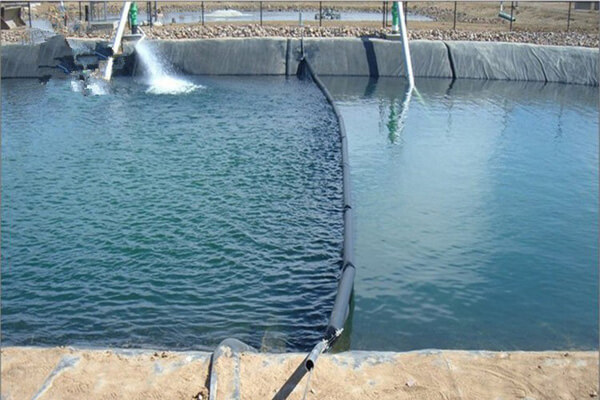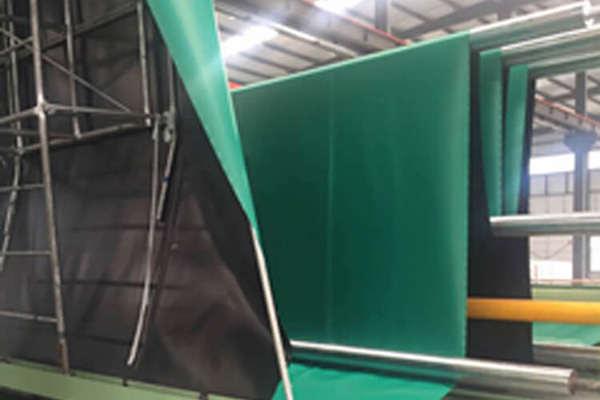HDPE Anti-seepage Geomembrane Construction Technology
Construction Process
1. Engineering surface requirements for HDPE anti-seepage film construction
(1) The quality of the base surface should meet the design requirements: the bottom surface of the foundation pit, the slope surface and the slope ratio, the anchoring groove on the slope, and the intersection of the slope surface and the right surface should meet the design requirements strictly.
(2) The base surface should be dry, compacted, flat, free of cracks, no obvious spikes, no muddy, no dents, and there should be no roots, rubble, stones, steel bars, glass shards within a vertical depth of 25 mm. The flatness should be gently changed within the allowable range, the slope is uniform, and the slope is consistent.
(3) The shadow of the yin and yang angle on the base surface is smooth and the root of the column should be arc-shaped.
(4) The surface of the substrate is dry, and the water content is preferably 15% or less.
(5) The substrate should be dense and uniform, and the dry density of the soil substrate should not be less than 1.4t/m2.
2. Climate requirements for HDPE impermeable membrane construction
(1) The temperature should generally be above five degrees Celsius. The geomembrane should be tense at low temperatures, and the wholesale LDPE geomembrane should be relaxed at high temperatures.
(2) The wind is below level 4.
(3) When the temperature is too low, winds of 4 or above and rain and snow should generally not be constructed.
(4) In the windy weather, when the wind affects the geomembrane construction, the HDPE geomembrane to be welded is pressed by the sandbag.
3. Precautions for HDPE anti-seepage film welding
(1) The power cord of the hot air gun, grinder and welder must be kept away from the working part to the maximum extent during use, so as to avoid leakage of the brain wire.
(2) Except for hot air welding, the mouth of the heat gun shall not be in surface contact with the HDPE film under any circumstances, and as far as possible away from the film surface, human body, machinery, and other objects.
(3) When not in use, the welder should not be placed directly on the HDPE film surface and should be placed on the bracket or sandbag belt.
(4) Immediately after use of the cutter, the blade should be retracted into the knife box.
(5) All kinds of temporary small tools used in the field should be put into the toolbox in time.
(6) It is strictly forbidden to directly discard the solder from the nozzle of the extrusion welding machine on the high quality LDPE geomembrane surface.
(7) HDPE anti-seepage film is prohibited from smoking at the construction site. Shoes with iron nails or high-heeled hard-soled shoes are not allowed to walk on the film surface. It is not allowed to engage in all activities that may damage the finished geomembrane.

Construction Preparation
(1) Check the debris removal in the field and clean it according to the design requirements. This is the key to ensure the anti-seepage effect, especially the sharp objects such as sharp stones and roots should be thoroughly cleaned, and local unevenness is not allowed on the base surface. Clean the base surface with a tamper or shackle to make it compact. Clean all debris to prevent the geomembrane from being pierced by debris. Prevent leakage during the use of the artificial lake in the future due to uneven density.
(2) Laying workers should wear soft-soled shoes to avoid damage to the high quality textured geomembrane.
HDPE Impermeable Film Laying
(1) Laying HDPE anti-seepage membrane is a key process in the entire anti-seepage system. Before the filming, the appearance quality of the HDPE anti-seepage film was unpacked, and the discovered mechanical damage and defects such as wounds, holes, and breakage were recorded and repaired.
(2) Before cutting the HDPE anti-seepage film, measure the relevant dimensions, and then cut according to the actual cutting. The seam width between the film and the film in the film laying is not less than 100mm so that the seam arrangement direction is parallel to the maximum slope. The foot lines are arranged along the slope direction.
(3) When laying HDPE anti-seepage film, the weld seam should be the least, and the raw materials should be saved as much as possible under the premise of ensuring the quality. It is also easy to guarantee quality. Usually, in corners and deformed areas, the length of the seam should be as short as possible. Except for special requirements, in the range of 1.5 m from the slope or stress concentration area on the slope with a slope greater than 1:6, no weld seam is allowed.
(4) During the laying of HDPE anti-seepage film, artificial folds should be avoided. When the temperature is low, it should be tightened and leveled as much as possible.
(5) After the HDPE anti-seepage film is completed, the walking and moving tools on the film surface should be minimized. Any objects that can cause damage to the HDPE anti-seepage film should not be placed on the film or carried on the film. In order to avoid accidental damage to the film.
HDPE Anti-seepage Film Welding
(1) The welding of HDPE anti-seepage film uses a wedge welding machine and adopts double-track hot-melt welding. Where the wedge welder cannot be welded, an extrusion hot-melt welder shall be used with a welding rod of the same quality as the raw material to form a single weld seam.
(2) The welding process of the hot boring machine is divided into adjusting the pressure, setting the temperature, setting the speed, checking the welding seam, loading the film into the machine, and starting the motor.
(3) There shall be no oil or dust at the joints. The overlapping surface of the HDPE anti-seepage film shall not have any debris such as sediment, condensation or moisture. When there is debris, it must be cleaned before welding.
(4) At the beginning of daily welding, a 0.9mm×0.3mm sample shall be first tested on the site, the overlap width shall not be less than 10cm, and the stripping and shear test shall be carried out on site. Adjust the speed, pressure, and temperature for normal welding. In the welding process, the hot welding machine needs to pay attention to the operation of the welding machine at all times, and the speed and temperature should be fine-tuned according to the actual situation on site.
(5) The welds are required to be neat and beautiful, and there must be no slip welding or jumping.
(6) When the length of the anti-seepage film is insufficient, long-distance splicing is required. The transverse welds should be welded first and then the longitudinal joints should be welded. The transverse welds should be T-shaped at a distance of more than 50 cm, and should not be crossed.
(7) When the welding film is not allowed to die, when the HDPE anti-seepage film is laid, the amount of expansion and contraction caused by the temperature change is reserved according to the local temperature variation range and the performance requirement of the HDPE anti-seepage film.
(8) Welding is not possible during rain or when there are moisture, dew, or sand in the joints.
(Except for protective measures).
(9) When the temperature is lower than 5 °C, it should not be constructed according to the specifications. If it is necessary to be applied, the welder should be preheated before welding.
(10) When the anti-seepage film is used for welding, whether it is powered by a local power supply or generator, the voltage must be kept stable, and a voltage regulator must be used if necessary.

HDPE Impermeable Membrane Anchoring
(1) There are three methods of anchoring: groove anchoring, nail anchoring, and expansion bolt anchoring; embedded parts are also used in some areas.
(2) Depending on the conditions of use and the force of the HDPE geomembrane, the anchoring groove width is generally 0.4m-1.0m and its depth is 0.4m-1.0m. Fold the edge of the impermeable membrane into the groove and fix it with stone, backfill or cement.
HDPE Anti-seepage Film Detection
(1) The test is carried out in three steps, namely visual inspection, inflation detection, and destruction test.
(2) The visual inspection is mainly to examine the appearance of the low cost textured geomembrane, weld quality, T-weld, and substrate debris. All construction personnel should carry out this work throughout the construction process.
(3) In addition to visual inspection, vacuum detection and air pressure detection may be used if necessary. The inflation intensity of the inflation pressure test is 0.25Mpa, and the air leakage is not leaked for 5 minutes. Considering that the coil is soft and easy to deform, the pressure is allowed to drop by 20%.
(4) When performing the tensile test (destructive test), the standard is that during the peeling and shearing test, the weld is not torn and the mother is torn by tearing, and the welding is qualified.
(5) Appearance inspection, if it is found that there are defects such as perforations on the film surface and leakage welding, virtual welding, damage, etc. during the welding process, it should be repaired with fresh base metal in time, and the side of each side is 10-20cm beyond the damaged part.
